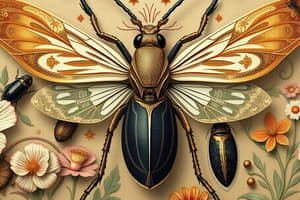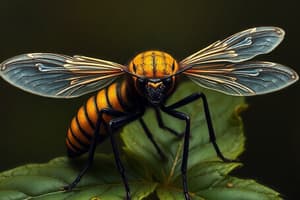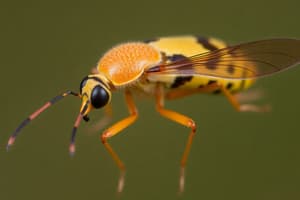Podcast
Questions and Answers
What does the term 'Insecta' refer to?
What does the term 'Insecta' refer to?
- Animals that live in water
- Animals with wings only
- Animals that cut into sections (correct)
- Animals with backbones
What are the main body parts of insects?
What are the main body parts of insects?
Head, thorax, and abdomen
Most insects are aquatic.
Most insects are aquatic.
False (B)
Name two common representatives of Insecta.
Name two common representatives of Insecta.
What is the life cycle of winged insects?
What is the life cycle of winged insects?
Insects only contribute negatively to human life.
Insects only contribute negatively to human life.
What is the relative complexity of Insecta?
What is the relative complexity of Insecta?
Who is the nearest relative of Insecta?
Who is the nearest relative of Insecta?
How many known species of insects are there?
How many known species of insects are there?
What process does metamorphosis of Insecta refer to?
What process does metamorphosis of Insecta refer to?
Adults of insects that do not undergo metamorphosis have wings.
Adults of insects that do not undergo metamorphosis have wings.
The incomplete metamorphosis of Insecta follows this sequence: Egg -> ______ -> Adult.
The incomplete metamorphosis of Insecta follows this sequence: Egg -> ______ -> Adult.
The complete metamorphosis of Insecta includes stages: Egg -> Larva -> Pupa -> ______.
The complete metamorphosis of Insecta includes stages: Egg -> Larva -> Pupa -> ______.
Flashcards are hidden until you start studying
Study Notes
Class Insecta
- Insecta means "cut into sections," referring to the segmented body structure of insects.
- The class is characterized by a body divided into three parts: head, thorax, and abdomen.
Characteristics of Insecta
- Insects typically have three pairs of legs and may possess two pairs of wings, capable of beating up to 100 times per second.
- Mouthparts are located on the head; they also have sensory organs, including one pair of antennae and compound eyes.
- Possess an exoskeleton and respire through a tracheal system (internal tubes and sacs).
- Simple circulatory system is present, with a heart.
- Exhibit bilateral symmetry and are multicellular organisms.
- Have a complete digestive system, enabling efficient processing of food.
- Many insects live in colonies, demonstrating social behavior.
Environment of Insecta
- Most insects are terrestrial, while a few species inhabit aquatic environments; very few are truly marine.
Common Representatives of Insecta
- Examples include dragonflies, cockroaches, termites, crickets, lice, beetles, fleas, flies, butterflies, bees, wasps, and ants.
Life Cycle of Insecta
- Winged insects go through complete metamorphosis: egg, larva, pupa, and adult.
- Wingless insects undergo incomplete metamorphosis: egg, nymph, and adult.
Importance of Insecta to Humans
- Insects are vital pollinators for plants, serve as food for various animals, and play a role in decomposing dead organisms.
- They recycle organic matter but can also transmit diseases and cause damage to crops.
Relative Complexity of Insecta
- Insects exhibit moderate complexity in their biological and ecological structures.
Nearest Relative of Insecta
- Insects are closely related to other members of the Phylum Arthropoda.
Other Facts about Insecta
- Over one million insect species have been identified, making them a highly diverse class that comprises more than 75% of all known animal species.
- Some insects can consume plants harmful to other animals, showcasing unique feeding adaptations.
- The oldest known insect fossil dates back around 400 million years to the Silurian period.
Metamorphosis of Insecta
- Metamorphosis is the biological process in which insects change shape during their life cycle.
- Complete metamorphosis involves significant transformation stages including larval and pupal forms.
No Metamorphosis of Insecta
- Some adult insects do not develop wings, indicating variations in development within the class.
Incomplete and Complete Metamorphosis of Insecta
- Incomplete metamorphosis follows a simple cycle of egg to nymph to adult.
- Complete metamorphosis includes distinct stages: egg, larva (resembling a worm), pupa, and fully developed adult with wings and antennae.
Studying That Suits You
Use AI to generate personalized quizzes and flashcards to suit your learning preferences.




